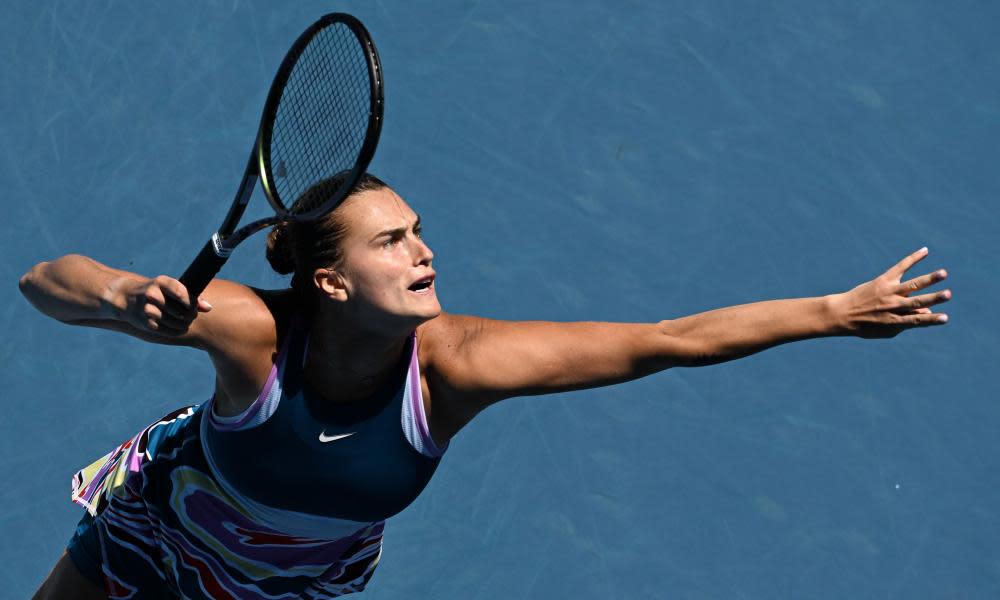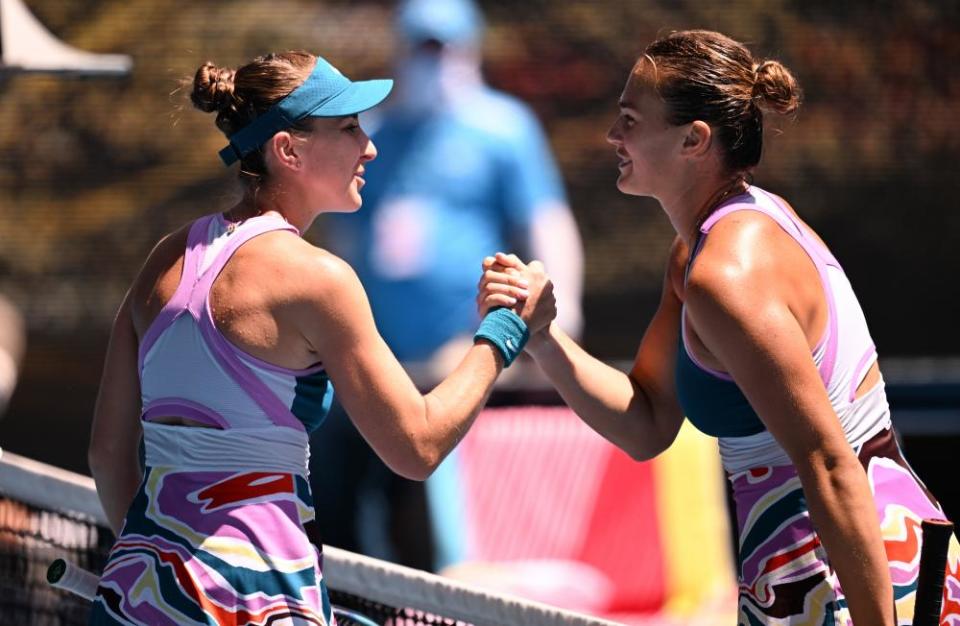Aryna Sabalenka serves up a storm at Australian Open after biomechanics help

As Aryna Sabalenka moved towards the finish line of her highly anticipated fourth round match against Belinda Bencic on Monday, she faced a perilous moment where everything could have changed. At 4-2 in the second set, having taken the first, Sabalenka fell 0-30 down on her serve.
What followed was a telling response. She landed three big first serves and a 96 mph second serve, which produced two un-returnable serves and two forehand winners. Sabalenka won four points in a row, she breezed through the rest of the match and reinforced herself as the favourite and most in-form player in the Australian Open draw with a 7-5, 6-2 win.
Related: Australian Open to stick with Dunlop despite criticism over fluffy balls
This time last year, the prospect of the Belarusian producing such a clutch serving sequence under pressure was laughable. While Sabalenka had always served a high number of double faults, she started last season with her serve in total meltdown. During a tournament in Adelaide, the 24-year-old simply could not land second serves in the court so she resorted to throwing in underarm serves. She finished the season with 440 double faults, 151 more than the second worst offender.
After spending much of last year just trying to manage the situation with her team, she eventually sought the far more drastic solution of working with a biomechanics specialist to reshape her service motion.
“I was, in that moment, open for whatever. I was just like, ‘Please, someone help me to fix this fucking serve,’” said Sabalenka.
Despite how frustrating it was to play tennis for so much of last year, Sabalenka says that she is happy she endured those difficult periods. She had previously thought her serving issues were the consequence of a mental block and persevered for a long time with the hope that it would resolve itself. Horrific serving performances forced her to confront the technical root of her issues and work on building a new service motion.
“I’m super happy that this thing with my serve happened to me before,” she said. “Before I wouldn’t be really open for that. I would be like, ‘You know what, my serve is fine, I don’t want to change anything.’ Actually, even when my serve was working, it wasn’t really right.”

During her biomechanics sessions, Sabalenka spent her time watching videos of herself, understanding why she had so many issues putting the serve in the court and then discussing how to reshape the service motion. “We watched a lot of videos. He was just showing what’s not really right about my serve, [why] there’s no way I can put it in. Just a lot of videos, a lot of talking, a lot of trying things,” she said.
It has changed significantly as a result. Her previous elaborate, hitchy motion has been replaced by a smoother, more abbreviated serve. While she tended to add slice to her serve, she has reduced her speed and focused on using more topspin. In her four matches at the Australian Open last year, she struck 56 double faults. This year, she has 11.
“I’ve done a lot,” she said. “I worked so hard. Even when my serve was, how did you say, ‘disaster’? I worked a lot on my serve. I kept trying, kept believing, kept changing.”
At the start of a fresh new season, the results have been clear. A year after serving 19 and 21 double faults in consecutive matches there, Sabalenka won her 11th career title in Adelaide. After four rounds in Melbourne, she still has still not dropped a set in 2023. Against Bencic, Sabalenka was spectacular, practically reducing the Swiss to a spectator with the force of her groundstrokes.
Related: Elena Rybakina stuns world No 1 Iga Świątek to reach Australian Open quarter-finals
Still, her success is a consequence of more than just an improved serve. As a teenager, Sabalenka emerged on the tour determined to crush every ball as hard as she could with minimal consideration of how to build points and make correct decisions. Then, as she established herself inside the top 10, she initially struggled badly at the grand slam tournaments, failing to pass the fourth round of any slam until 2021.
At the beginning of this season, those issues have been resolved. Sabalenka is playing smarter tennis, with more topspin on her forehand and more consideration of when and how to hit the ball. She is still a nuclear ball-striker who hits as big a ball as anyone on the tour, but with both temperament and approach she has learned how to play a more sustainable style of tennis. Additionally, she reached her third grand slam semi-final at the US Open, and the pressure of competing at the biggest events has abated.
After the exit of world No 1 Iga Świątek on Sunday, Sabalenka is the clear favourite in the women’s draw and she has played the best tennis of all other players since the start of the year. She will face the in-form Donna Vekić in the quarter-final, who ended the run of the 17-year-old Linda Fruhvirtova, winning 6-2, 1-6, 6-3. Meanwhile, France’s Caroline Garcia, the fourth seed, was upset 7-6(3), 6-4 in the fourth round by Poland’s Magda Linette.

 Yahoo News
Yahoo News 
